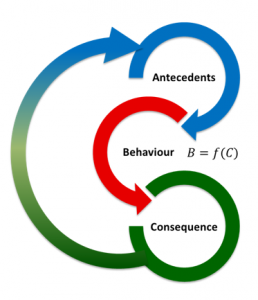
The truth is, our behaviour is based more on our learning from experience than following instruction. However, if a rule is written to keep us safe, or an instruction is given that will make our company more profitable, why wouldn’t we follow it?
Until 1983, it was not a legal requirement to wear a seatbelt in your car in the UK, however it had been a legal requirement to fit them in cars for fifteen years. If, like me, you are old enough to remember 1983, you will recall that prior to the change in the law, most people did not wear a seatbelt. If we apply some logic, you would think that protecting yourself from the very painful experience of smashing your windscreen with your face would be motivation enough to ‘clunk, click every trip’. So why do we behave in ways that introduce unnecessary danger into our lives? Well behavioural science gives us the answer. Our behaviour, in the main, is influenced by the consequences of previous behaviours. Let’s take a look at the seatbelt example. What are the actual consequences of not wearing a seatbelt? Well you save a little time before driving away, you have an improvement in comfort and looking out of the rear window while reversing is easier. All these are positive, so why wear a seatbelt at all? The negative consequence of being 30 times more likely to be ejected from the car in an accident is not apparent, because most journeys do not result in a serious accident. (With 36,000,000 vehicles on the road in the UK, we have 750 fatalities a year for vehicle occupants). So the consequences that we have ourselves experienced in the past, drive our behaviour in the future. By introducing a legal consequence of not wearing a seatbelt, compliance went up to 90% overnight. This is because the consequence of a fine or imprisonment is one that is tangible to us all. Over the years, society has come to recognise the consequence of breaking the law, and most of us choose to observe the law. So by introducing a real consequence that is perceived as both likely and negative, behaviour has been changed effectively.
of previous behaviours. Let’s take a look at the seatbelt example. What are the actual consequences of not wearing a seatbelt? Well you save a little time before driving away, you have an improvement in comfort and looking out of the rear window while reversing is easier. All these are positive, so why wear a seatbelt at all? The negative consequence of being 30 times more likely to be ejected from the car in an accident is not apparent, because most journeys do not result in a serious accident. (With 36,000,000 vehicles on the road in the UK, we have 750 fatalities a year for vehicle occupants). So the consequences that we have ourselves experienced in the past, drive our behaviour in the future. By introducing a legal consequence of not wearing a seatbelt, compliance went up to 90% overnight. This is because the consequence of a fine or imprisonment is one that is tangible to us all. Over the years, society has come to recognise the consequence of breaking the law, and most of us choose to observe the law. So by introducing a real consequence that is perceived as both likely and negative, behaviour has been changed effectively.
So in a world where behaviour is influenced by consequence, why do we spend so much time managing antecedents?
If future behaviour is influenced by consequences of previous behaviour, how can we use this in the workplace? It’s as easy as ABC! First we have an Antecedent. This is simply something that precedes a behaviour, in the workplace this could be a procedure, a safety sign, a rule or instruction. This is followed by the resultant Behaviour. Then there will be one or more Consequences of this behaviour.  This consequence has now become the antecedent of future behaviour. Behaviour is a function of consequence. By managing consequences we can easily influence future behaviour. So in a world where behaviour is influenced by consequence, why do we spend so much time managing antecedents? There is a lot of science around this and lots of tools we can use to analyse and manage consequences. However, by just thinking in terms of consequence management we can start to change the culture of a workplace and increase the frequency of safe, positive behaviours. An old-school manager will immediately start to think about negative consequences for undesirable behaviours. While these may have their place, more constructive results can be found by introducing positive consequences for desirable behaviours. After all, why wait for someone to do something wrong before introducing a managed consequence. By rewarding desirable behaviours we can possibly avoid the undesirable behaviours all together!
This consequence has now become the antecedent of future behaviour. Behaviour is a function of consequence. By managing consequences we can easily influence future behaviour. So in a world where behaviour is influenced by consequence, why do we spend so much time managing antecedents? There is a lot of science around this and lots of tools we can use to analyse and manage consequences. However, by just thinking in terms of consequence management we can start to change the culture of a workplace and increase the frequency of safe, positive behaviours. An old-school manager will immediately start to think about negative consequences for undesirable behaviours. While these may have their place, more constructive results can be found by introducing positive consequences for desirable behaviours. After all, why wait for someone to do something wrong before introducing a managed consequence. By rewarding desirable behaviours we can possibly avoid the undesirable behaviours all together!
The results are clearly desirable, with increased performance requiring less management time.
Picture the manager who writes a lengthy procedure and then disciplines any team member who fails to comply. This might lead to a team of people who follow the procedure. However, they will be complying through fear of retribution rather than a genuine desire to do the job correctly. By rewarding people for following the procedure correctly, you create a culture where people want to get the job right from the outset. The end point is a team culture where individuals automatically encourage high performance from new starters or visiting contractors. The results are clearly desirable, with increased performance requiring less management time. Who wouldn’t want that!?
So stop thinking, ‘how can I stop people doing the wrong thing’ and start thinking ‘how can I help people do the right thing’.
